CBS Fender Telecasters: what you need to know
Custom Telecaster or Telecaster Custom? We clear up the confusion on CBS-era Teles...

The Telecaster has appeared in many different guises since the basic design went to market in 1950. Fender’s first solidbody electric guitar, the single (bridge) pickup Esquire, was introduced during spring 1950, while the odd dual-pickup Esquire was made that summer.
Fender decided to launch these dual-pickup instruments separately as the Broadcaster in autumn 1950, though following a trademark disagreement with Gretsch they were rebranded Telecaster in early 1951. This landmark electric guitar is now celebrating its 70th anniversary.
The Telecaster continued to evolve throughout the 50s, transitioning away from the original Blackguard livery in 1954 with a lighter blonde finish and white pickguard. The model’s greatest change would come in 1959 when rosewood fingerboards became standard across the Fender line.
In June that year, the Esquire and Telecaster Custom models appeared, their bound bodies resplendent in a three-tone sunburst finish and topped with a three-ply (w/b/w) nitrate pickguard. These instruments marked Fender’s first foray away from the traditional ‘plain Jane’ design.
As the 60s progressed, bigger changes were afoot at Fender as a whole, and by 1965 the brand was firmly in the hands of its new owners CBS. For better or worse, the corporate giant was less bound by tradition and soon began to take the humble Tele into areas previously unimagined.
Telecaster Thinline

In 1962, pioneering guitar designer Roger Rossmeisl departed fellow Californian guitar builder Rickenbacker to join Fender. After helping launch the firm’s acoustic guitar range in 1963, he moved on to develop the semi-hollowbody electric Coronado design in early 1966 before beginning work on a hollow Telecaster design the following year.
With its non-contoured body, the Tele proved an ideal testbed for such experimentation, and by 1968 Rossmeisl and his assistant, Virgilio Simoni, had refined a method of construction for a new Telecaster model.
Get The Pick Newsletter
All the latest guitar news, interviews, lessons, reviews, deals and more, direct to your inbox!
Launched in 1968, the Telecaster Thinline initially came in either a natural ash or mahogany finish; a three-tone sunburst option became available later in the year. In 1971, the standard Telecaster pickup configuration was superseded by dual Wide Range humbuckers designed by father of the Gibson PAF, Seth Lover. The model remained in production throughout the 1970s until it was pulled from the catalogue at the end of the decade.
Paisley Red & Blue Flower Telecasters

Equally striking a departure from the traditional Telecaster design were the Paisley Red and Blue Flower Teles that appeared in limited numbers in 1968. With Fender hoping to connect with the zeitgeist of flower power, these two markedly psychedelic finishes were achieved by using a peel-and-stick product made by the Borden Chemical company called Cling-Foil.
This aluminium foil (effectively a thick metallic wallpaper) was fixed to the wood before being blown over around the body edges and pickup routs.
“Paisley Red pulsates with every beat and swirls in a blinding carousel of colour forms and tones. Fender shines again,” says an advert for the Paisley Red Telecaster. Its Blue Flower counterpart reads: “Blue Flower bursts forth in a dazzling array of subtle purple and green patterns. Never before has such an exciting profusion of colour been offered.”
Unfortunately, many of these rare Teles suffered from severe fading and checking.
Telecaster Custom

While the original dual-single-coil/sunburst Telecaster Custom was discontinued in 1972, that same year a radically overhauled design appeared. Advertised as the Telecaster Custom (though often referred to as the “Custom Telecaster”), the new model sported the unique configuration of a regular Tele-style single-coil bridge pickup along with a Wide Range humbucker in the neck position.
Featuring Les Paul-style controls, including independent pickup volume and tone pots and a three-way switch on the upper bass bout, the newly designed ‘version two’ Telecaster Custom offered players a unique combination of sounds that covered both Gibson and Fender territory.
From 1973, with the introduction of the dual-’bucker Telecaster Deluxe, three out of four of Fender’s Tele designs carried the new Wide Range pickup; only the standard Tele retained its existing dual single coils. This latter version of the Telecaster Custom was discontinued in 1981 (along with the Telecaster Deluxe).
Telecaster Deluxe

As hard rock became more popular during the late 60s and early 70s, new Tele designs evolved in order to meet demand while existing models fell by the wayside.
By 1970, both the Esquire and Esquire Custom guitars were discontinued, followed by the original/sunburst Telecaster Custom and the George Harrison-endorsed Rosewood Telecaster in ’72. The Telecaster Deluxe made its debut soon after in ’73, hoping to compete with Gibson’s Les Paul Standard directly with a dual-humbucker-loaded guitar.
Like its contemporary Telecaster Custom model, the hybrid-design Telecaster Deluxe features Les Paul-style controls and a large scratchplate. In addition, it has a CBS-era Stratocaster-style wide headstock, “micro-neck-adjust” three-bolt neckplate system, and ‘belly cut’ rear contour.
Early on, the Telecaster Deluxe was also offered with a Strat-style “tremolo” option. Larger frets and a 9.5-inch radius complete its unique feel. It remained at the top of the Telecaster price list throughout its production.
- Guitarist would like to thank ATB Guitars in Cheltenham and Adrian Hornbrook
Rod Brakes is a music journalist with an expertise in guitars. Having spent many years at the coalface as a guitar dealer and tech, Rod's more recent work as a writer covering artists, industry pros and gear includes contributions for leading publications and websites such as Guitarist, Total Guitar, Guitar World, Guitar Player and MusicRadar in addition to specialist music books, blogs and social media. He is also a lifelong musician.
“It combines unique aesthetics with modern playability and impressive tone, creating a Firebird unlike any I’ve had the pleasure of playing before”: Gibson Firebird Platypus review
“This would make for the perfect first guitar for any style of player whether they’re trying to imitate John Mayer or John Petrucci”: Mooer MSC10 Pro review










